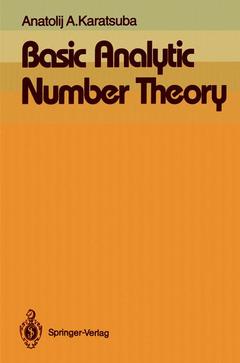Basic Analytic Number Theory, Softcover reprint of the original 1st ed. 1993
Langue : Français
Auteur : Karatsuba Anatolij A.

This English translation of Karatsuba's Basic Analytic Number Theory follows closely the second Russian edition, published in Moscow in 1983. For the English edition, the author has considerably rewritten Chapter I, and has corrected various typographical and other minor errors throughout the the text. August, 1991 Melvyn B. Nathanson Introduction to the English Edition It gives me great pleasure that Springer-Verlag is publishing an English trans lation of my book. In the Soviet Union, the primary purpose of this monograph was to introduce mathematicians to the basic results and methods of analytic number theory, but the book has also been increasingly used as a textbook by graduate students in many different fields of mathematics. I hope that the English edition will be used in the same ways. I express my deep gratitude to Professor Melvyn B. Nathanson for his excellent translation and for much assistance in correcting errors in the original text. A.A. Karatsuba Introduction to the Second Russian Edition Number theory is the study of the properties of the integers. Analytic number theory is that part of number theory in which, besides purely number theoretic arguments, the methods of mathematical analysis play an essential role.
I. Integer Points.- §1. Statement of the Problem, Auxiliary Remarks, and the Simplest Results.- §2. The Connection Between Problems in the Theory of Integer Points and Trigonometric Sums.- §3. Theorems on Trigonometric Sums.- §4. Integer Points in a Circle and Under a Hyperbola.- Exercises.- II. Entire Functions of Finite Order.- §1. Infinite Products. Weierstrass’s Formula.- §2. Entire Functions of Finite Order.- Exercises.- III. The Euler Gamma Function.- §1. Definition and Simplest Properties.- §2. Stirling’s Formula.- §3. The Euler Beta Function and Dirichlet’s Integral.- Exercises.- IV. The Riemann Zeta Function.- §1. Definition and Simplest Properties.- §2. Simplest Theorems on the Zeros.- §3. Approximation by a Finite Sum.- Exercises.- V. The Connection Between the Sum of the Coefficients of a Dirichlet Series and the Function Defined by this Series.- §1. A General Theorem.- §2. The Prime Number Theorem.- §3. Representation of the Chebyshev Functions as Sums Over the Zeros of the Zeta Function.- Exercises.- VI. The Method of I.M. Vinogradov in the Theory of the Zeta Function.- §1. Theorem on the Mean Value of the Modulus of a Trigonometric Sum.- §2. Estimate of a Zeta Sum.- §3. Estimate for the Zeta Function Close to the Line ? = 1.- §4. A Function-Theoretic Lemma.- §5. A New Boundary for the Zeros of the Zeta Function.- §6. A New Remainder Term in the Prime Number Theorem.- Exercises.- VII. The Density of the Zeros of the Zeta Function and the Problem of the Distribution of Prime Numbers in Short Intervals.- §1. The Simplest Density Theorem.- §2. Prime Numbers in Short Intervals.- Exercises.- VIII. Dirichlet L-Functions.- §1. Characters and their Properties.- §2. Definition of L-Functions and their Simplest Properties.- §3. The Functional Equation.- §4. Non-trivial Zeros; Expansion of the Logarithmic Derivative as a Series in the Zeros.- §5. Simplest Theorems on the Zeros.- Exercises.- IX. Prime Numbers in Arithmetic Progressions.- §1. An Explicit Formula.- §2. Theorems on the Boundary of the Zeros.- §3. The Prime Number Theorem for Arithmetic Progressions.- Exercises.- X. The Goldbach Conjecture.- §1. Auxiliary Statements.- §2. The Circle Method for Goldbach’s Problem.- §3. Linear Trigonometric Sums with Prime Numbers.- §4. An Effective Theorem.- Exercises.- XI. Waring’s Problem.- §1. The Circle Method for Waring’s Problem.- §2. An Estimate for Weyl Sums and the Asymptotic Formula for Waring’s Problem.- §3. An Estimate for G(n).- Exercises.- Hints for the Solution of the Exercises.- Table of Prime Numbers < 4070 and their Smallest Primitive Roots.
Date de parution : 10-2012
Ouvrage de 222 p.
15.5x23.5 cm
© 2024 LAVOISIER S.A.S.



